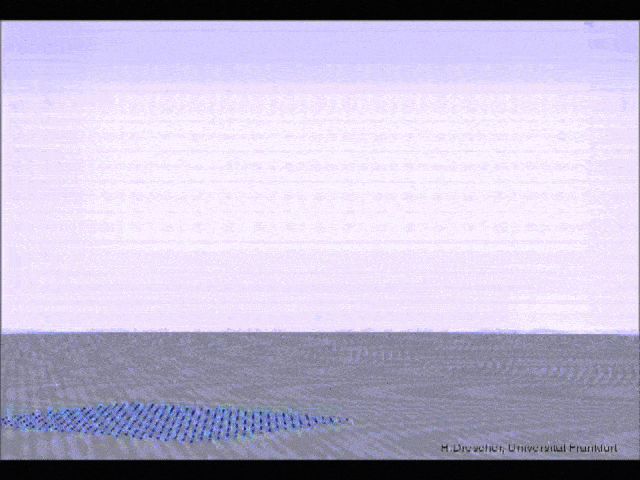FREQUENTLY ASKED QUESTIONS
Where does the harvested electricity come from?
The SUN. The high-voltage DC electricity harvested by ion collectors comes from electrically charged ions in the atmosphere produced by the Sun. Additionally, Cosmic Rays consistently impact oxygen and nitrogen atmospheric atoms producing a particle shower creating electrically charged ions downward along its path through the atmosphere, day and night. In addition to being a conveyance of high-voltage electricity, ions play an equally important role causing the atmosphere to be electrically conductive allowing ion collectors to benefit greatly from disturbed weather. For example, when a storm or active cloud formation is nearby, the harvested power can skyrocket many orders of magnitude by reason of the electrical conductivity of the atmosphere provided by airborne ions. This naturally generated energy is collected in a storage medium (capacitors, ultra-capacitors, fuel cells) providing the ability to do work such as power lights, motors or produce hydrogen gas from water. Geographic areas with radon gas can tend to have greater ionic airborne densities due to the gas leaking up from the ground. To a degree not yet defined, man-made air pollution can raise the level of airborne ion densities. Cities with polluted air may prove to enjoy an extra benefit from ion harvesting. Ion collectors harvest atmospheric electricity produced by multiple sources. Ion Harvesting Technology should not be confused with other techniques that harvest manmade radio frequency (Rf) energy.
 Depiction to the right of cosmic rays penetrating the atmosphere impacting electrically neutral oxygen and nitrogen atoms creating a particle shower (or particle cascade) producing electrically charged atmospheric ions along its path. This natural process occurs on Earth and Mars day and night (and theoretically all planets with an atmosphere, independent of sunlight).
Depiction to the right of cosmic rays penetrating the atmosphere impacting electrically neutral oxygen and nitrogen atoms creating a particle shower (or particle cascade) producing electrically charged atmospheric ions along its path. This natural process occurs on Earth and Mars day and night (and theoretically all planets with an atmosphere, independent of sunlight).
Does ion harvesting work at night?
YES. Because ions are present in the atmosphere day and night, ion-harvesting can operate day and night and at greater power levels during disturbed weather. Ion harvesting does not require sunlight or wind to harvest the electric charge of atmospheric ions to produce electricity.
Does ion harvesting work on Earth?
YES.Useable power has been repeatedly harvested, stored, and utilized at the Florida test facility producing light and operating motors and producing hydrogen gas from water. Ion Power Group intends to build the world’s first Ion Power Plant for trail-runs on Earth after adequate funding becomes available.
Will ion harvesting pollute the Earth or Mars?
NO. The process of harvesting electricity from naturally occurring ions in the Martian atmosphere and Earth’s atmosphere is completely passive and non-polluting. No fumes, smoke, toxins, waste or pollution is produced. Ion-harvesting is a clean, renewable source of electrical energy.
Does ion harvesting require wind to operate?
NO. Ground based circuitry maintains the ion collector material at a voltage considerably lower than the surrounding atmospheric ions thereby employing the electrostatic attraction principle causing nearby ions to migrate to the ion collectors.
Ion harvesting for Cars and Drones?
Possibly YES. Ion Power Group has been awarded a patent for applying ion collectors to vehicles for the generation of supplemental electricity to help power vehicles and/or their onboard systems. Early stage R&D tests demonstrate that ion collectors affixed to a vehicle (a truck) generate electricity. With additional development, potential benefits include improved efficiency and greater mileage for electric powered cars and hydrogen powered cars via ion collectors providing supplemental electrical power thus reducing the demand on the vehicle primary power system. Aircraft, drones, water vehicles and spacecraft are also candidates to be equipped with ion collectors.
How can ion harvesting be used to produce hydrogen gas?
Water Electrolysis is a process employed to produce hydrogen gas and oxygen gas from ordinary water. However, electrolysis requires electricity in order to separate the hydrogen and oxygen atoms that compose water. Ion Power Group’s ion harvesting technology can provide clean electricity to be used in the electrolysis of water into hydrogen and oxygen gas on Mars and the Earth. Ion Power Group was awarded a patent for using ionic electricity harvested from the atmosphere to split water to produce hydrogen and oxygen gas. This is the same type hydrogen gas that will power fuel-cell cars being developed by the world’s largest automakers. A demonstration video clip of hydrogen gas being produced from water powered by ion harvesting technology can be viewed on the Proof-of-Concept Clips page.
Is Ion harvesting anticipated to work during dust storms on Mars?
YES. Much of the electrical activity on Mars is caused by dust storms as well as bombardment of galactic cosmic rays from deep space which cause the atmosphere to be electrically conductive. Because dust storms are a highly energetic source of atmospheric electricity, the power level harvested by ion collectors is expected to increase during dust storms.
How much electricity can ion harvesting produce on Mars?
 Power output is dependent on the altitude provided to the ion collectors and the size of the geographic area covered by the ion-collectors. Kilowatt output is feasible depending on the duty cycle placed on the storage medium. Theoretically megawatt output is possible on an industrial scale depending on the duty cycle.
Power output is dependent on the altitude provided to the ion collectors and the size of the geographic area covered by the ion-collectors. Kilowatt output is feasible depending on the duty cycle placed on the storage medium. Theoretically megawatt output is possible on an industrial scale depending on the duty cycle.
What happens when all the ions are used up?
It is not possible to deplete the atmospheric ions on Mars or the Earth. Nature constantly replenishes the ion population of the atmosphere of both planets. Consistent bombardment by GalacticComicRays (GCRs) plus frequent storms are some of the natural forces that replenish and maintain the ion population of the atmosphere. Consistent bombardment byGalacticComicRays (GCRs) plus frequent lightning discharges on Earth (4,320,000 lightning discharges each 24 hour period) are some of the natural forces that replenish and maintain the ion population of Earth’s atmosphere. Because Mars has a weak magnetic field, GCRs propagate effectively through the atmosphere producing electrically charged ions along their path. Ion harvesting is a clean renewable pollution-free, environmentally-friendly source of electricity.
What equipment can be powered by ion collectors on Mars?
Ion collectors are designed to charge a storage medium (such as super-capacitors, batteries or hydrogen fuel cells) day, night and during dust-storms. The storage medium can be dawn upon to help power lights, heat, life-support, communication and entertainment equipment, rovers, robots, drones and vehicles. Ionic energy harvested from the Martian atmosphere can be used to melt Martian ice into liquid water (or acquire it from the soil) for drinking and agriculture and also raising fish. Electricity harvested from ions in the Martian atmosphere can be used to electrolyze Martian water into oxygen for breathing and hydrogen gas for rocket fuel.
Patents?
YES. Patents have been awarded by the USA, and foreign countries.
What is an ion?
Electrically neutral oxygen and nitrogen atoms fill the atmosphere. When oxygen or nitrogen atoms are struck by GCRs (Galactic Cosmic Rays) arriving from deep space, sometimes an electron is knocked away causing the atom to become electrically imbalanced or ‘charged’. An atom possessing an electric charge is known as an ion. Ions can also be created when a neutral atom gains an extra electron. An electron imbalance, whether a loss or a gain of electrons, converts an atom into an ion. This is a natural process that occurs day and night on most planets possessing an atmosphere, such as Mars (with different types of atoms).
